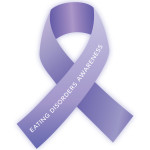
- Anorexia nervosa: People with anorexia drastically limit their food intake and have an intense fear of gaining weight, even though they might be significantly low weighted.
- ARFID: Avoidant restrictive food intake disorder, which is marked by unhealthy weight, nutritional deficiency, and/or interference with social functioning without having a fear of gaining weight or body image concerns.
- Binge eating disorder (BED): People with BED eat an unusually large amount of food in a short period of time and feel a loss of control during this episode. They do not purge afterwards, but often feel a lot of shame or guilt about their binge eating.
- BMI: Body mass index (BMI) is a number that is calculated for someone’s weight and height. This number helps determine whether or not someone is below, in, or above their healthy weight range.
- Bone density: A measure of how strong your bones are.
- Bulimia nervosa: Cycles of binge eating followed by a purging behavior. People with bulimia will eat an unusually large amount of food in a short period of time and then exercise excessively or purge by self-inducing vomiting, using laxatives, enemas, or diuretics in an attempt to avoid gaining weight.
- CBT (cognitive behavioral therapy): A type of therapy that teaches you how to be alert to the thoughts you have as you do certain behaviors. CBT targets thoughts and behaviors that are unhealthy or unhelpful. The focus of CBT is to decrease negative thoughts or unhealthy behaviors.
- Challenge foods: Foods that people with eating disorders try to avoid because they may be considered unhealthy or because eating them may lead to binging or purging/vomiting. They may also be called “trigger” or “risk” foods.
- DBT (dialectical behavioral therapy): A type of therapy that encourages patients to embrace the thoughts and feelings they have but to think in ways that prevent harmful behaviors. It’s primarily a group-based therapy with individual therapy back-up. Patients keep logs of their thoughts and feelings and learn and discuss coping strategies.
- DXA scan: A test that measures bone density.
- ED behaviors: A term used to describe habits that people develop when they have an eating disorder. Behaviors may include vomiting after meals, cutting food into very small pieces, counting calories, exercising obsessively, overeating, skipping meals or eating very small meals, etc.
- EKG: A test that looks at the activity and rhythm of the heart.
- Electrolytes: nutrients (such assodium, potassium, and chloride ) that keep the heart and body working properly.
- Exchanges: A term used to describe servings of foods from different food groups. Some meal plans are based on the exchange system, meaning they are divided into main groups (protein, fat, starch/grain, beverage, dairy, fruit, and vegetable).
- Family-based treatment (FBT): A type of therapy that empowers parents to learn ways to get their child to eat. The therapist meets with the whole family and does not explore emotional issues, but supports the parents in feeding their child and supports the child in their efforts to recover. The goal of family-based treatment is weight restoration. This type of therapy is sometimes referred to as the “Maudsley” approach.
- Family therapy: A type of therapy that involves you and your family members meeting with a therapist. It can be a helpful place to discuss family issues and tensions while there is a therapist or counselor there to find a solution.
- Group therapy: Is when peers share experiences and stories with each other, and is usually led by a therapist or counselor.
- Median body weight: The average weight for a particular height.
- Meal plan: An eating plan that is designed by your registered dietitian. A meal plan gives recommendations about the amount and types of food you should eat to achieve or maintain a healthy weight.
- OSFED: Other specified feeding or eating disorder, which is some combination of symptoms of eating disorders such as an intense fear or weight gain and a preoccupation with food (thinking about food or having food related thoughts most of the day) that does not meet clinical diagnosis for another eating disorder.
- Purging: Describes any behavior that someone with an eating disorder uses to “get rid of” calories. Purging behaviors include vomiting, taking laxatives, diet pills, or excessive exercise.
- Safe foods: Foods that people with eating disorders feel they can eat comfortably. Safe foods are often unprocessed, low-fat, or low-calorie foods, but can be different for every person.
- Trigger: Anything that makes someone want to engage in certain behaviors or have eating disordered thoughts.
- Vital signs: Measurements which include body temperature, blood pressure, and pulse.
- Weight goal range: A range of weight that your treatment team decides is a healthy weight for your recovery. It takes into account what a person weighed before the eating disorder. A person’s weight range will increase as they grow and get older.
Source: Read Full Article
